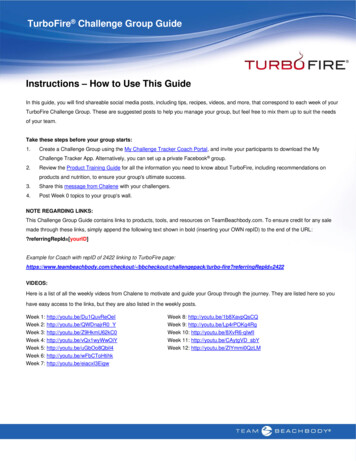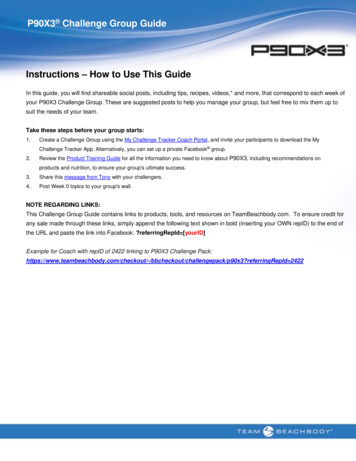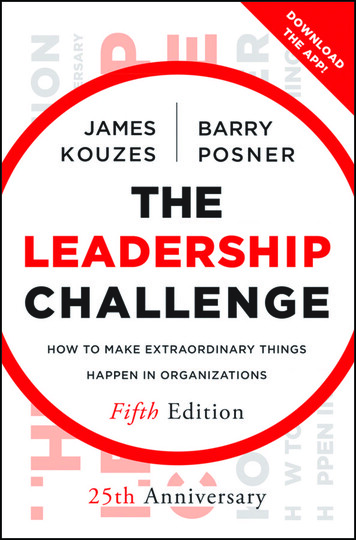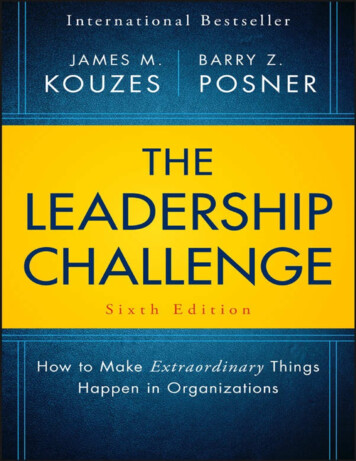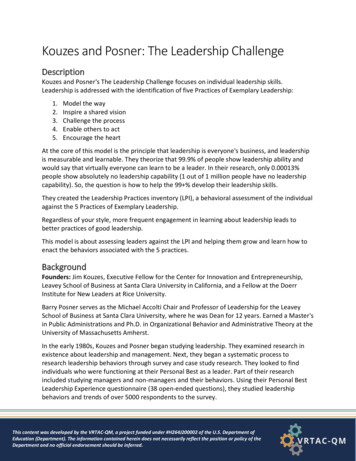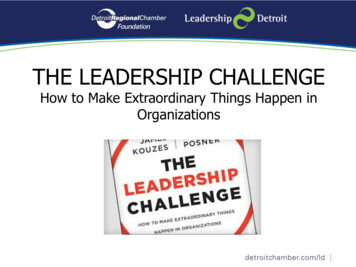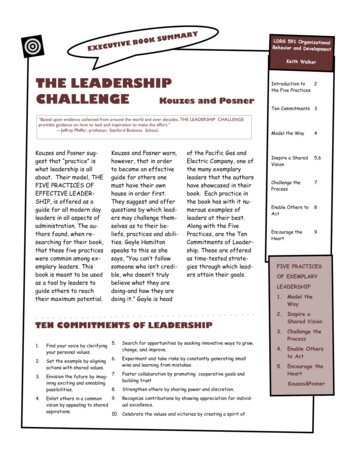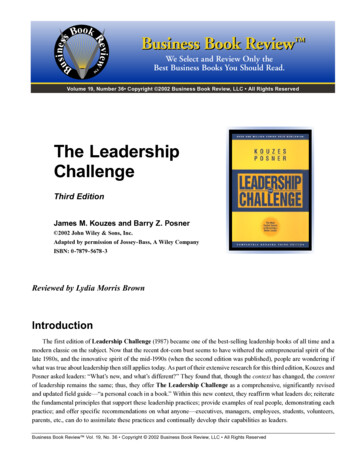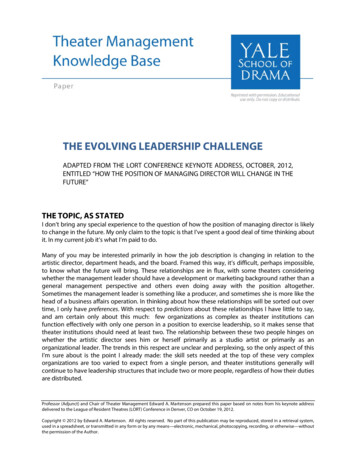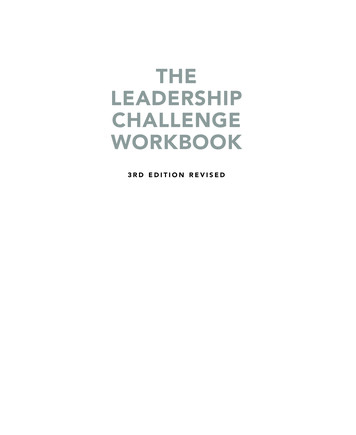
Transcription
THELEADERSHIPCHALLENGEWORKBOOK3RD EDITION REVISED
THELEADERSHIPCHALLENGEWORKBOOK3RD EDITION REVISEDJAMES M. KOUZESBARRY Z. POSNER
Copyright 2017 by James M. Kouzes and Barry Z. Posner.Published by The Leadership Challenge, A Wiley BrandOne Montgomery Street, Suite 1000, San Francisco, CA 94104-4594—www.leadershipchallenge.comAuthor photo by John Brennan.No part of this publication may be reproduced, stored in a retrieval system, or transmitted in any form or by any means,electronic, mechanical, photocopying, recording, scanning, or otherwise, except as permitted under Section 107 or 108of the 1976 United States Copyright Act, without either the prior written permission of the publisher, or authorizationthrough payment of the appropriate per-copy fee to the Copyright Clearance Center, Inc., 222 Rosewood Drive,Danvers, MA 01923, 978-750-8400, fax 978-646-8600, or on the Web at www.copyright.com. Requests to thepublisher for permission should be addressed to the Permissions Department, John Wiley & Sons, Inc., 111 RiverStreet, Hoboken, NJ 07030, 201-748-6011, fax 201-748-6008, or online at www.wiley.com/go/permissions.Limit of Liability/Disclaimer of Warranty: While the publisher and author have used their best efforts in preparingthis book, they make no representations or warranties with respect to the accuracy or completeness of the contentsof this book and specifically disclaim any implied warranties of merchantability or fitness for a particular purpose. Nowarranty may be created or extended by sales representatives or written sales materials. The advice and strategiescontained herein may not be suitable for your situation. You should consult with a professional where appropriate.Neither the publisher nor author shall be liable for any loss of profit or any other commercial damages, including butnot limited to special, incidental, consequential, or other damages. Readers should be aware that Internet Web sitesoffered as citations and/or sources for further information may have changed or disappeared between the time this waswritten and when it is read.Certain pages from this book are designed for use in a group setting and may be customized and reproduced foreducational/training purposes. The reproducible pages are designated by the appearance of the following copyrightnotice at the foot of each page:The Leadership Challenge Workbook, Third Edition Revised. Copyright 2017 by James M. Kouzes and Barry Z.Posner. Published by The Leadership Challenge, A Wiley Brand.This notice may not be changed or deleted and it must appear on all reproductions as printed. This free permission isrestricted to limited customization of materials for your organization and the paper reproduction of the materials foreducational/training events. It does not allow for systematic or large-scale reproduction, distribution (more than 100copies per page, per year), transmission, electronic reproduction or inclusion in any publications offered for sale or usedfor commercial purposes—none of which may be done without prior written permission of the Publisher.For additional copies or bulk purchases of this book or to learn more about The Leadership Challenge , please contactus toll free at 1-866-888-5159 or by email at leadership@wiley.com.Wiley also publishes its books in a variety of electronic formats and by print-on-demand. Some material included withstandard print versions of this book may not be included in e-books or in print-on-demand. If the version of this bookthat you purchased references media such as a CD or DVD that was not included in your purchase, you may downloadthis material at http://booksupport.wiley.com.For more information about Wiley products, visit www.wiley.com.ISBN 978-1-119-39756-4 (pbk); ISBN: 978-1-119-42713-1 (ePDF)Printed in the United States of Americathird edition revisedPB Printing10 9 8 7 6 5 4 3 2 1
ContentsIntroduction11How to Use This Workbook72The Five Practices of Exemplary Leadership113Selecting Your Personal-Best Leadership Project194Model the Way295Inspire a Shared Vision496Challenge the Process757Enable Others to Act918Encourage the Heart1099Reflecting on Your Personal-Best Leadership Project127 10 The Challenge Continues143AcknowledgmentsAbout the Authors145147V
INTRODUCTIONWHEN WE INTERVIEWED DON BENNETT for our first book, he said somethingthat we’ve never forgotten. Don is the first amputee to climb Mt. Rainier. That’s 14,410 feeton one leg and two crutches.“How did you make it to the top?” we asked Don.“One hop at a time,” was his instant reply.One hop at a time. One hop at a time. One hop at a time.When you think about it, that’s how most extraordinary things are accomplished. Asmuch as you might desire it, you simply cannot leap to the top of a mountain. You can onlyget there by taking it one step at a time—or, as in Don’s case, one hop at a time.Yet we sometimes find ourselves simply paralyzed by the mere scale of the challenge. Weare challenged to do more with less, adapt quickly to changing circumstances, innovate onthe fly, deal with extreme uncertainty, and somehow still find time for our families andfriends. Sometimes it’s all just too overwhelming. But so is looking up to the top of thatmountain when you are at the bottom. That’s why Don would tell himself, as he looked just1
THE LEADERSHIP CHALLENGE WORKBOOK2one foot ahead, “Anybody can hop from here to there.” And so he did—fourteen thousandfour hundred ten times.But Don had something else in mind when he looked up at the top of that mountain.Despite what you might have heard about why people climb mountains, it’s not becausethey’re there. When we asked Don to tell us why he wanted to be the first amputee to climbMt. Rainier, he told us it was because he wanted to demonstrate to other disabled peoplethat they were capable of doing more than they might have thought they could do. Donhad aspirations that went beyond individual glory and success. He was the one doing theclimbing, but he was not climbing just for himself. He was climbing for an entire community. He had a vision of others doing great things.And there’s another lesson we learned from Don that’s directly applicable to leadingothers to make extraordinary things happen. We asked him, “What’s the most importantlesson you learned from this climb?” Without hesitation, he said, “You can’t do it alone.”We produced The Leadership Challenge Workbook so that you can apply to your projectsthe leadership lessons we have learned from Don Bennett—and from the thousands ofother leaders we have studied. This is a practical guide that is designed to help you use TheFive Practices of Exemplary Leadership —the model of leadership derived from, and validated by, more than thirty years of research—as a tool for planning and preparing for yournext climb to the summit.The Leadership Challenge Workbook is a one-hop-at-a-time guide for leaders. It’s a toolthat asks you to reflect on each essential element of leading and to act in ways that incrementally create forward momentum. It asks you to think beyond your personal agenda andimagine how your leadership efforts engage others’ desires. And because you can’t do it alone,it also helps you involve others in the planning and the doing. ARE YOU LEADING AT YOUR “PERSONAL BEST”?When we began our research, we wanted to find out what practices characterize exemplaryleadership, so we created a question that framed everything else. The question we askedeveryone we studied was; “What did you do when you were at your ‘personal best’ as aleader?” We did not want to know what the most famous and the most senior leaders did.We wanted to know what leaders at all levels and in all contexts did.
3 Model the WayInspire a Shared VisionChallenge the ProcessEnable Others to ActEncourage the HeartYou might already be familiar with The Five Practices from our book The LeadershipChallenge, which describes this research in detail. Or you might know The Five Practicesbecause you have used our 360-degree assessment instrument, the LPI : Leadership PracticesInventory , to further your development as a leader. In case the practices are new to you,we provide a brief overview in Chapter 2 of this workbook.Whether you are familiar with our other work or not, we ask you to keep this in mind:When you engage in The Five Practices more frequently than you do at present, you will bemore effective. We know from our research that those who Model, Inspire, Challenge,Enable, and Encourage more frequently significantly increase their probability of makingextraordinary things happen, compared with those who do so less frequently. Exemplaryleadership, in other words, is not an accident of birth or circumstance. It’s a result of conscious and conscientious practice. PROJECTS PROVIDE THE CONTEXTProjects are how we tend to organize work these days. Projects create the context for ourgoals, determine with whom we work, and set our schedules. We will be more specific inChapter 3 about what kind of project to select, but you might start thinking now aboutINTRODUCTIONWe asked people to tell us a story about one project they led that they considered theirPersonal-Best Leadership Experience—an experience that set their individual standard ofexcellence. We collected thousands of stories of leaders performing at their peak, and welooked for actions that were consistent across all the stories.After many years—and several thousand quantitative and qualitative analyses—we foundthat there are Five Practices that define exemplary leadership.When operating at their best, leaders:
THE LEADERSHIP CHALLENGE WORKBOOK4something you are currently leading or about to lead that could benefit from the applicationof exemplary practices.One important point to keep in mind is that every new project you take on providesyou with an opportunity. It’s an opportunity to do things the same way you have alwaysdone them, or it’s an opportunity for greatness—an opportunity to achieve another personalstandard of excellence. It all depends on how you approach the challenge.No world-class athlete ever set foot on the playing field saying to himself or herself,“Well, I think I’ll settle for performing at my average today.” The same is true of world-classleaders. Every day is an opportunity to improve performance, and the most challengingprojects are the ones that create the most opportunity. Your next project is your chance tocreate extraordinary results for your organization and to develop your leadership capabilities.This workbook is designed to help you plan and prepare so that you can lead at your personalbest.WHO SHOULD USE THE LEADERSHIP CHALLENGEWORKBOOK?This workbook is designed for anyone in a leadership role. Its purpose is to help you furtheryour abilities to lead others in making extraordinary things happen. Whether you are in theprivate or public sector, an employee or a volunteer, a first-line supervisor or a senior executive, a student or a parent, you will find that this workbook applies to you. That’s becauseleadership is not about being in a formal position. It’s about action. You can grant someonethe title of manager, but that does not make him or her a leader. Leadership is earned.You get to be a leader in the eyes of others because of what you do. Leadership is abouthaving the courage and spirit to move from whatever circumstances you are in to a place ofmaking a difference in the world. This workbook is designed to help anyone who has thedesire to lead and the will to make a difference. It’s for anyone who is in a role that requiresmobilizing others to want to struggle for shared aspirations.LEADERSHIP IS EVERYONE’S BUSINESSThe next time you say to yourself, “Why don’t they do something about that?” look inthe mirror. Ask the person you see, “Why don’t you do something about that?” By accepting
5Jim Kouzes, Orinda, CaliforniaBarry Posner, Berkeley, CaliforniaMay 2017INTRODUCTIONthe challenge to lead, you come to realize that the only limits are those you place onyourself.While our research has taught us many things about the practice of leadership, ourinteraction with the thousands of individuals we have studied has taught us something vitallyimportant. It’s driven home the lesson that leadership is everyone’s business. We need moreleaders today, not fewer. We need more people to accept responsibility for bringing aboutsignificant changes in what we do and how we do it. We need more people to answer thecall. The world is in great need of your talents.We believe that you are capable of developing yourself as a leader far more than traditionor mythology has ever assumed possible. Simply imagine yourself standing at the base ofMt. Rainier, and then start climbing—one hop at a time.We wish you great joy and success on your next leadership adventure. Onward andupward!
CHAPTER 1HOW TO USE THISWORKBOOKTHE BEST LEADERS are continually learning. They see all experiences as learning opportunities. But there’s one condition. Rich insights only come from reflection and analysis.Unexamined experiences yield no lessons. If you want to become a better leader, you needto study your own performance and become more conscious about the choices that you aremaking and how you are acting on your intentions.The purpose of The Leadership Challenge Workbook is to help you become a better leaderby applying The Five Practices of Exemplary Leadership to a project of your choice. As withthe learning of any new discipline, we will ask you to do some exercises that isolate specificskills. This may seem a bit artificial at first, but it’s no different from any form of practice—you are not actually in the game, but you know you are improving your capacity to playthe game.7
THE LEADERSHIP CHALLENGE WORKBOOK8HOW THE WORKBOOK IS ORGANIZEDIn Chapter 2 we’ve provided a summary of The Five Practices model that resulted from ourthirty-plus years of research. If you’ve read The Leadership Challenge or have used theLeadership Practices Inventory, you may not need to review the model, but it’s here if youneed a reminder. If you are not already familiar with The Five Practices, read this chaptercarefully—it provides the foundation for the work that you will be doing.Chapter 3 offers some guidelines for choosing the right leadership project. To enableyou to focus your work, it’s essential that you select a real project to serve as the target ofyour reflections, applications, and actions. In Chapters 4 through 8, you’ll apply The FivePractices to that project. And in Chapter 9, which you’ll complete after your project is finished (or well underway), you will find questions that will help you reflect on the project’shighs and lows and on what you learned—lessons you can then apply to your next PersonalBest Leadership Project.As you progress through the activities, the workbook supports your success in three ways:1. Reflection. We want you to think about how you approach leadership. The questions wepose are designed to challenge your thinking and help you become more consciousabout how well you engage in each of The Five Practices. Contrary to myths aboutleadership that assume you either have it or you don’t, we know from our research thatthe very best leaders spend time examining what they have done as well as what theyare planning to do. Call it the “mental game of leadership.” The exercises in this workbook ask you to be more reflective about what your experience can teach you aboutleadership.2. Application. We want you to apply the leadership practices and commitments toyour project. To do that, we provide exercises that help put The Five Practices ofExemplary Leadership to work. In some cases you will do this application alone. Inother cases, you will go out to talk to your team members and engage them in anactivity.3. Implications. As a result of your reflections and applications, you will learn about yourself, your team, your organization, and your project. At the end of each chapter, we askyou to jot down the implications of what you have learned about leadership.
9It would be ideal if you could complete the entire workbook as a way of preparing everyonefor the project—somewhat like a series of warm-up exercises before playing the game. Ona practical level, that may not be possible. The way you use the workbook depends on thenature of your project and your situation. Here are some suggestions: If you’re just starting, we recommend that you begin with Chapter 4 on Model the Wayand work your way through Chapter 8 on Encourage the Heart.If your project has been underway for some time, we recommend that you first readthrough this workbook quickly, without completing all the activities. Then go back andstart with those worksheets that address immediate concerns. For example, your teammay have been working long hours and has not taken a break. You believe that theyneed some recognition and celebration. In that case, start with Chapter 8, Encouragethe Heart. Or you may feel that conflicts have arisen because there is insufficient consensus around shared values. In that instance, begin with Chapter 4 on Model the Way.However, make sure you address all of The Five Practices and complete all the activitiesas soon as you can. They are designed to improve the way you lead.You may find that you have already completed some of the activities that are in thisworkbook. For instance, you and your team may have spent a lot of time identifyingand agreeing upon your shared values. If you have already done something equivalentto what’s in this workbook, then just pause long enough to make sure you are comfortable with what you have done and do not need to revisit it. Then move on to the nextactivity.You may decide that you want to start with a particular chapter—say Chapter 7 insteadof Chapter 4—because you think the activities in that chapter are more important toyour team right now. Or you may find that some questions are richer and more usefulto you than others. That’s okay with us. Start with the practice that most needs yourattention. We encourage you to proceed through this book in whatever way resonatesfor you.No matter how you use the workbook, however, we urge you not to skip over any ofthe leadership practices.HOW TO USE THIS WORKBOOKGUIDELINES FOR COMPLETING THE WORKBOOK
THE LEADERSHIP CHALLENGE WORKBOOK10At times you may find yourself saying, “I don’t know.” For example, we are going toask, “Who’s on your project team?” Your answer today may be, “I don’t know. The teammembers haven’t been selected yet.” That’s a perfectly acceptable response. If you are notready to answer a question or complete an activity, set the workbook aside and do what youneed to do so that you can respond or engage in action, or simply move on to the nextquestion or activity and come back when you are ready. What’s important is that you comeback to everything that you skip.Becoming a better leader requires learning and doing something in each of The FivePractices. You may be better at some than others, but you still have to develop your capacityto execute in all of them. It’s like participating in a pentathlon. You can’t opt out of any ofthe five events if you want to enter. You may feel that you are better prepared for someof the events than for others, but you must still participate in all five.
Contents Introduction 1 1 How to Use Th is Workbook 7 2 Th e Five Practices of Exemplary Leadership 11 3 Selecting Your Personal-Best Leadership Project 19 4 Model the Way 29 5 Inspire a Shared Vision 49 6 Challenge the Process 75 7 Enable Others to Act 91 8 Encourage the Heart 109 9 Refl ecting on Your Personal-Best Leadership

